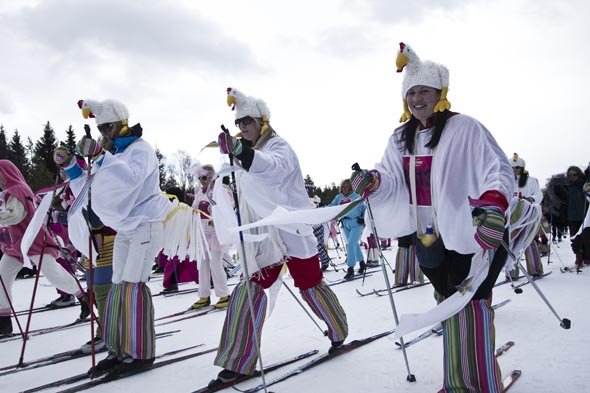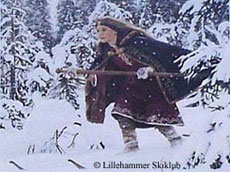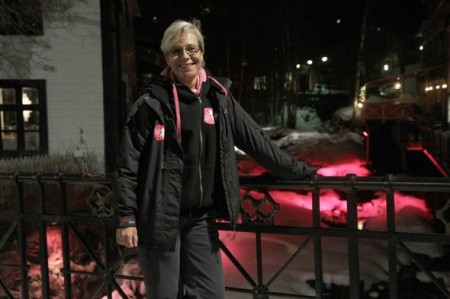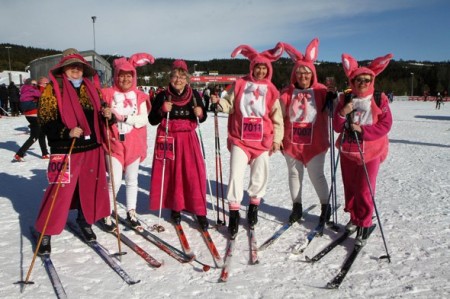
Norway is a country that takes skiing very, very seriously. Many of the best World Cup skiers? Norwegian. The largest wax and softgoods company (Swix)? Norwegian. They’ve got a ski brand (Madshus); the biggest marathon in the World (the Birkebeiner); and among the best exercise scientists, looking specifically at nordic athletes.
The crown jewel of Norway’s ski obsession is Lillehammer, where so many of the companies and events mentioned above are based. Host of the 1994 Olympics, the city will also be the site of the opening World Cup cross country races for the next several seasons.
But even in Norway, girls just want to have fun. And that’s the premise of the Inga-Låmi, a women’s-only ski race that has been held in the Birkebeiner Skistadion outside Lillehammer since 1993.
As I sat in a conference room with Elisabeth Winther, the race’s lead organizer, on Tuesday, she handed me a book that had been made with photos of last year’s race, which had about 4,000 participants. As I flip through the pages I see teenagers in Norway’s trademark red Swix suits; grown women in matching pink costumes; mothers and grandmothers skiing together. Here’s a shot of women stretching together on the start line. There’s one of Lillehammer’s main street, decked out for tourists and parties.
There’s no way not to get sucked in: despite my mostly-retired status as a racer, this is one competition that I’d really like to do.
“The main thing is to go on the train with your friends, and go away from the family situation,” Winther said of the Inga-Låmi’s allure. “Leave them and have a fun weekend all together with the other girls… What we sell is the whole weekend: come with your girlfriends and have fun talking, drinking, eating, shopping. We have a lot of culture events going on that weekend. A lot happens.”
Finding Inga

To get women out skiing and having fun: that was the original goal of the Inga-Låmi. To make it happen organizers resurrected the character of Inga, the mother of Håkon Håkonsson, the infant prince of the Birkebeiner legend. Inga from Varteig, as she is known, was a single mother, not the queen of Norway but instead the daughter of an innkeeper. Håkon was born in the summer of 1204, a few months after his father, the king, died in both mysterious circumstances and the midst of a civil war.
Two warriors – the skiers so famously depicted on Birkebeiner logos in both Norway and the United States – fetched the mother and son to take them north to safety. While they skied with the child to Lillehammer, Inga seems to have followed behind, and reuniting with the group later and traveling all the way north to the Birkebeiner capital to help raise him.
But her role in Norwegian history was not over. When her son’s paternity – and position as king – was in doubt, she went through an ordeal of carrying hot iron in her bare hands; when, three days later (and, it was assumed, by the grace of God) her hands were healed as if nothing had happened, the people accepted that young Håkon was indeed the son of the king.
Håkon Håkonsson was a strong king that reigned over a prosperous time in Norwegian history, and what few traces of his mother appear in the sagas point to her beauty, strength, and bravery. “Låmi” means in the tracks, so the women who race today are following in Inga’s tracks. But it took some excavation of the history books to bring Inga to the fore.
“The story is kind of forgotten about her – she is forgotten,” Winther said. “So what people know about is those two guys bringing the kid. It is important for us to tell the story.”
In the twenty-odd years since the race’s inception, it has been through several iterations. In the beginning, it was almost entirely a party. Many of the women dressed up in costumes – both funny ones and traditional Norwegian ski garb from the days of yore.
“We had an Olympic feeling with bells and skirts and all these flags and so on,” Winter said. “In 1999 we had almost 5,000 ladies coming, but it turned into kind of a party race. The ski club didn’t want a party race, they wanted to have a sport profile.”

The race is owned by the Lillehammer Skiklub, which is also the partial owner of the Birkebeiner. They wanted to have a serious race, so they raised the distance to 30 kilometers, starting with 15 kilometers on the Olympic trails – which are quite difficult. Immediately, the character of the race changed. When Winther took over in 2005, there were only 2,800 participants.
Part of her job has been bringing the numbers back up, which requires balancing the need for sport and competition with the need for fun and escape. Now, there are three races on Inga-Låmi day: 30 k, which also serves as a seeding race for the Birkebeiner; 15 k, on more rolling terrain on the Birkebeiner and Inga-Låmi trails; and a 5 k costume race. Entries are growing every year, albeit slowly.
Different Goals
While the Birkebeiner sells out in hours (as we discussed with its director earlier this week), the women’s race has no cap, and you can even show up and register the morning of the race. It also has a completely different feel.
“I bet we are the only ski race in the world that rents out skis,” Winther laughed. “Because, you know, I forgot my skis in the hotel room, or my poles are gone, or my shoes are on the bus… so at our information desk up there you can rent skis. Some of the women, they are really lost.”
That’s probably because some start drinking the night before. Others show up at the stations where Skiklub volunteers wax their skis with the same wax still on their kickzones as they had last year. Still others come with their companies, which organize whole events around the Inga-Låmi: the men act as a service team, the women compete, and then the whole group parties that night. Gender-role-reversed teambuilding.
“Most of them are touring, and especially in the costume race they are stopping and sitting at the fireplace where they serve sausages and something to drink,” Winther said of the participants. “They are walking. We have music and dancing.”

In case participants needed any extra reasons to sign up, the race also partners with a different philanthropic organization each year. In 2012, the recipient of their fundraising was Norway’s breast cancer foundation, which like the Inga-Låmi was celebrating its 20th anniversary. The race branded everything pink: the Dale sweaters they sold, the decorations downtown. They even cast pink light over the river in celebration.
This year, women can check a box on their entry form to support the Red Cross. Next year the focus will be on women’s heart health. Donating, Winther said, is popular.
The afternoon before I met with Winther, I skied the 15 k loop that the race calls its own. While the Birkebeiner itself traverses a 1,000-meter tall mountain range, the Inga-Låmi uses only the last few kilometers of the Birkebeiner trail, as well as a trail section named after Inga herself, which rolls through bogs and past picturesque black-cold ponds. With or without 4,000 other women, the trails were delightful, and completely skiable.
(“The nature is nice,” Winther smiled.)
Consistent with the Skiklub’s goals, there is also a serious side to the race. More and more women are using the more technical 30 k as a way to get seeded into the Birkebeiner, which takes place the next weekend. For them, says Winther, the goal is to be the first across the finish line – then let loose and have fun. Last year, the top finisher was Norwegian legend Hilde Gjermundshaug Pedersen. Next? Her daughter Ida.
(This year, three or four former Olympic racers will come, and Winther is organizing a race amongst the group of them, which should be fun to watch.)
Training and health in general are big focuses for the organization. As Birkebeiner director Rune Bergsodden had mentioned as well, culture and worklife are becoming more and more sedentary. The races serves as a tool for training motivation, to stay healthy month in and month out.
“What is important for us to tell is that you have to do the training during the year, so that you can be good for yourself and all the people around you,” Winther said. “You give yourself a gift of being able to start at the Inga-Låmi because you have been doing your work during the year. Be good to yourself and take this weekend here.”
Indeed, like the Birkebeiner, the Inga-Låmi will soon be a “triple”, with three races in different sports. The serious competitors want more races in the other disciplines that they train in for the rest of the year; the less serious ones want another excuse to come hang out in Lillehammer. For both, a mountain bike race will be on the schedule in 2015.
“They say, ‘we want to have three weekends in Lillehammer during the year,’” Winther explained. “But they don’t want to be in the area where the boys are, they want to have their own area… Cross country now is very ‘in’, and the ladies in our race want to do biking and running as well.”
It’s the Economics, Stupid

As fun as the Inga-Låmi supposedly is – and by the end of the interview, I’m literally dying to come back and see for myself in March – the expansion into a triple probably wouldn’t be possible if it didn’t make economic sense. But, and this is important for race organizers around the world to take note of: it does.
“We’ve taken statistics, and in 48 hours, it’s between eight and ten thousand Norwegian kroner per person with traveling and shopping!” Winther said. “It’s the most of any of the events. They are really shopping – Christmas presents for the kids, things for their husbands. And they are spending a lot of money. Our 4,000 women spend more than the 16,000 Birkebeiners in a 48-hour period.”
That means that the locals are a lot more likely to support the race, and, in the future, races. In the last few years, the county of Oppland has grown into the third-best represented in the race itself; before, Winther said, local women had avoided the hubbub because they could “ski the loop anytime.” Now they both participate and thank the race for bringing a bit more cash into their economy.
Organizers had contemplated a triple before, but rather than a three-sport one, the three-ski-race variety, joining with the Vasaloppet’s Tjej-Vasan (“girl-Vasa”) and one other event. The International Ski Federation (FIS) put the kibosh on that idea, Winther said, but didn’t stop information from flowing between the races.
“We’re learning a lot from the Vasaloppet organization,” Winther said. “It’s interesting because they had organized the Tjej-Vasan as just one ski club, and they saw that they didn’t grow as big as they wanted, so they put the race into the big Vasaloppet system. Then they had the power for marketing and sponsors and everything, and they grew. I think they have 10,000 now.”
Organizers are now contemplating doing the same for the Inga-Låmi. Because the Birkebeiner is owned by both the Lillehammer Skiklub and its counterpart in Rena, the start of the longer race, bringing the women’s day into the fold would entail the Rena club buying half of it from Lillehammer.
Winther seemed enthusiastic about the idea, but also wary of growing too quickly.
“What we say is that we deliver quality, and in my opinion we don’t want to grow that fast,” she said. “We want to grow slowly so that we can make sure that there is quality all the time.”
She was skeptical that her race could grow as large as the Tjej-Vasan, which has 10,000 participants; after all, Sweden has twice the population of Norway. But for the Birkebeiner organization, the race seems like a good investment, and would lead to marketing opportunities that would benefit everyone.
“The family market is very interesting,” Winther said. “Saturday we have the race for the women, Sunday it’s kids, and then the husband can go in the Birkebeiner race the weekend after. So if we could sell that as a family package, one week or a little bit more. It could be very interesting.”
Chelsea Little
Chelsea Little is FasterSkier's Editor-At-Large. A former racer at Ford Sayre, Dartmouth College and the Craftsbury Green Racing Project, she is a PhD candidate in aquatic ecology in the @Altermatt_lab at Eawag, the Swiss Federal Institute of Aquatic Science and Technology in Zurich, Switzerland. You can follow her on twitter @ChelskiLittle.



